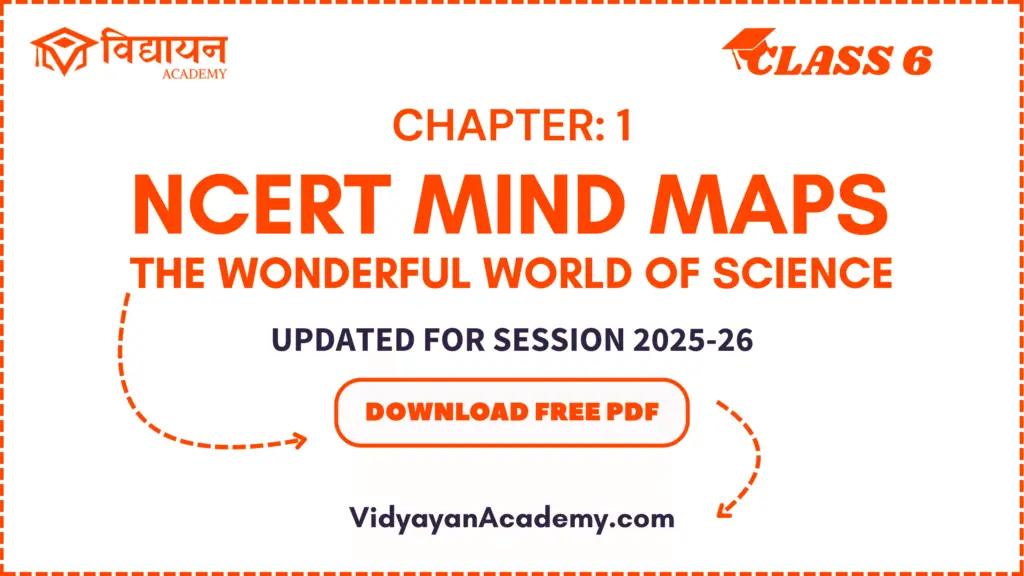Mind Map for Class 6 Science Chapter 2 – Diversity in Living World [PDF Download]
Introduction
Download the mind map for Class 6 Science Chapter 2 Diversity in Living World PDF by Vidyayan Academy to make learning simple and effective. This mind map for Class 6 Science Chapter 2 presents the entire chapter in a visual format, showing plants, animals, habitats, adaptations, and conservation in one place. Instead of going through long notes, students can revise quickly with this easy diagram. The mind map for Class 6 Science Chapter 2 Diversity in Living World helps in better understanding, improves memory, and makes last-minute exam revision stress-free. Perfect for students, teachers, and parents, this free PDF is a complete learning and revision tool
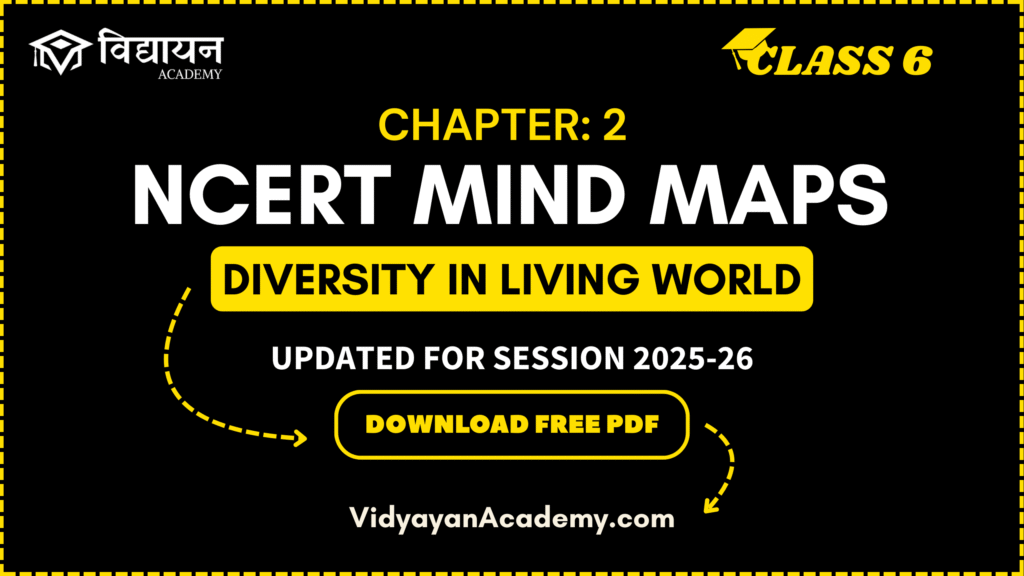
For many students, remembering all the details of this chapter can feel a little overwhelming. That’s where a mind map comes in handy. A mind map is like a picture of the whole chapter drawn in one place. Instead of reading long paragraphs, you get to see the concepts neatly arranged in branches and diagrams.
Table of Contents
To make learning easier, Vidyayan Academy has designed a mind map for Class 6 Science Chapter 2. It is available in a simple PDF download, and it can completely change the way you revise before exams.
Download the Mind Map PDF
You can download the mind map for Class 6 Science Chapter 1 – The Wonderful World of Science Free PDF for easy offline access. It’s designed for CBSE Class 6 and is perfect for homework, projects, and quick reviews.
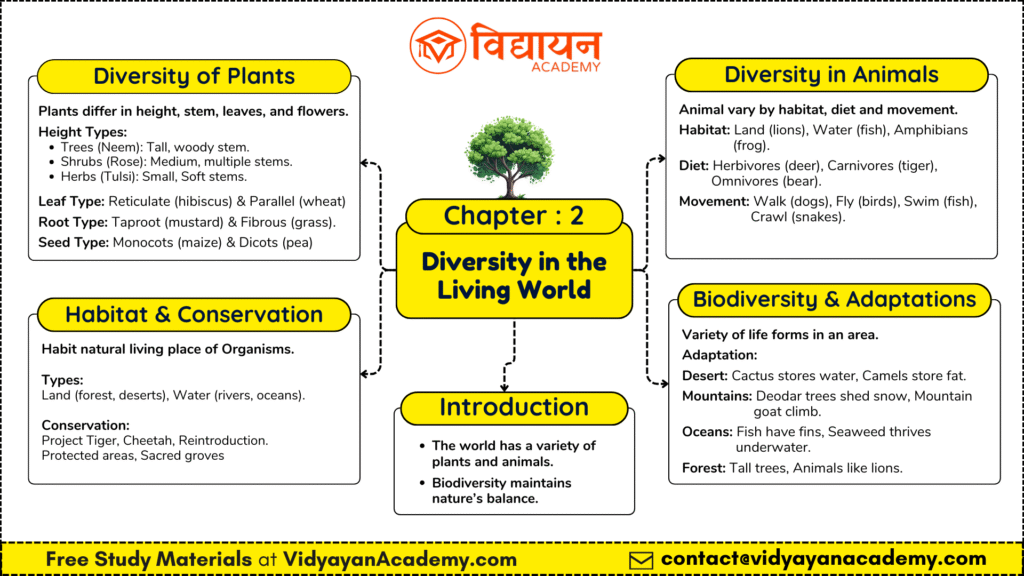
Download free pdf of Mind Map for Class 6 Science Chapter 1 – The Wonderful World of Science
You can download the PDF of the mind map for Class 6 Science Chapter 1 of updated NCERT curriculum for session 2025-26 . We’ll also share worksheets for practice so that learning becomes both fun and effective.
Science Chapter 1 – The Wonderful World of Science: Download Free Pdf
Why Choose a Mind Map for Class 6 Science Chapter 2?
Every student has a different style of learning. Some like reading, some prefer listening, and many find visuals the easiest way to remember things. A mind map for Class 6 Science Chapter 1 – The Wonderful World is powerful because it combines both words and visuals. Here’s why this tool is especially useful:
- It simplifies the whole chapter on a single page.
- It helps students remember faster because the brain easily stores pictures.
- It saves a lot of time during revision before exams.
- It keeps learning engaging and less stressful.
- Teachers can also use it in classrooms to explain topics clearly.
That’s why the mind map for Class 6 Science Chapter 2 Diversity in Living World is one of the best ways to study.
Also visit:
- Mind Map Class 6 Science Chapter 1 – The Wonderful World of Science
- How to Create the Perfect Study Timetable for Class 10 Students | The Pomodoro Technique
- How Do Airplanes Fly? Must know Physics Behind it.
- 5 Proven Group Discussion Skills for Student Success.
What Does Chapter 2 – Diversity in Living World Teach Us?
This chapter tells us how living things around us are not all the same. Every plant and animal is unique. The variety of life on Earth is called biodiversity. The chapter also explains how plants and animals are grouped, how they adapt to their surroundings, and why conservation is important.
Let’s take a closer look at each part of the chapter with the help of the mind map prepared by Vidyayan Academy.
1. Diversity in Plants
Plants show variety in their stems, leaves, roots, and seeds.
- By stem and size:
- Trees – Tall, woody plants with branches high above the ground. Example: Neem, Mango.
- Shrubs – Medium plants with woody stems branching near the ground. Example: Rose, Hibiscus.
- Herbs – Small plants with soft green stems. Example: Tulsi, Tomato.
- Climbers and Creepers – Plants with weak stems that climb or spread. Example: Money plant (climber), Pumpkin (creeper).
- By leaf venation:
- Reticulate venation – Net-like veins (Example: Hibiscus, Mustard).
- Parallel venation – Veins run parallel (Example: Grass, Wheat, Banana).
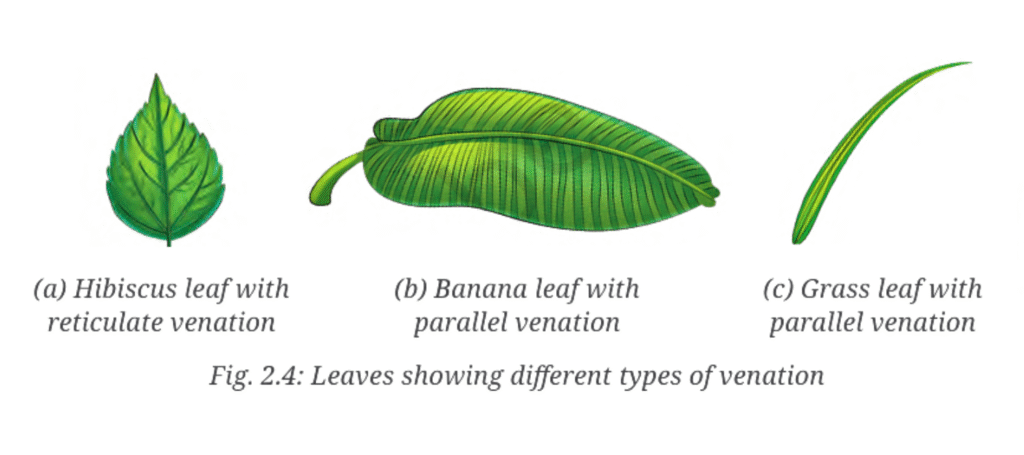
- By root type:
- Taproot – One main root with small branches (Example: Mustard, Hibiscus, Radish).
- Fibrous root – Many thin roots from the stem base (Example: Grass, Wheat, Maize).
- By seeds:
- Dicots – Seeds with two cotyledons, reticulate venation, and taproots (Example: Chickpea, Pea).
- Monocots – Seeds with one cotyledon, parallel venation, and fibrous roots (Example: Maize, Rice).
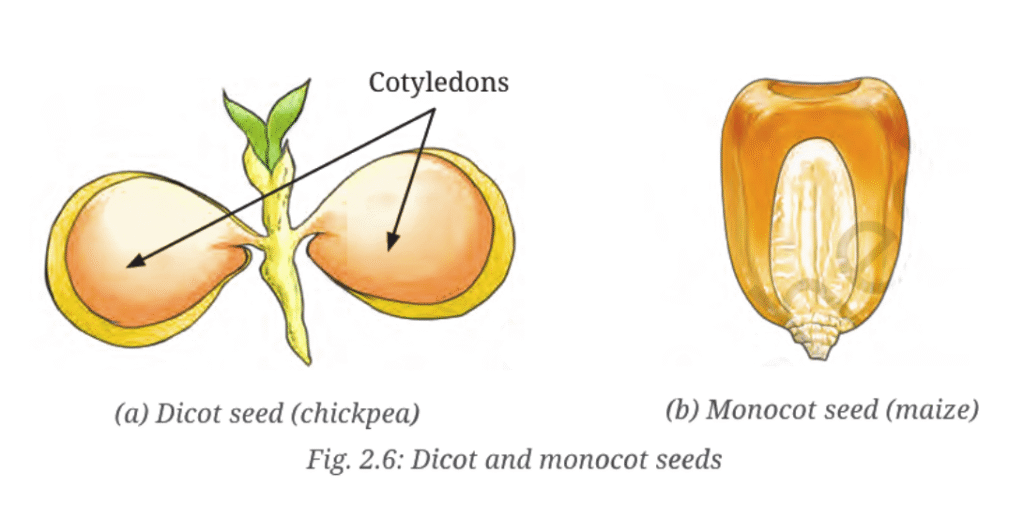
2. Diversity in Animals
Animals are different in their habitats, food habits, and movement.
- By habitat:
- Land animals – Lions, Tigers, Dogs.
- Water animals – Fish, Whales.
- Amphibians – Frogs (live on land and in water).
- By food:
- Herbivores – Eat plants (Deer, Cow).
- Carnivores – Eat animals (Tiger, Lion).
- Omnivores – Eat both plants and animals (Bear, Crow).
- By movement:
- Walk – Dogs, Goats.
- Fly – Birds, Pigeons.
- Swim – Fish.
- Crawl – Snakes, Earthworms.
Every animal uses special body parts for movement. Birds use wings, fish use fins, and goats use legs.
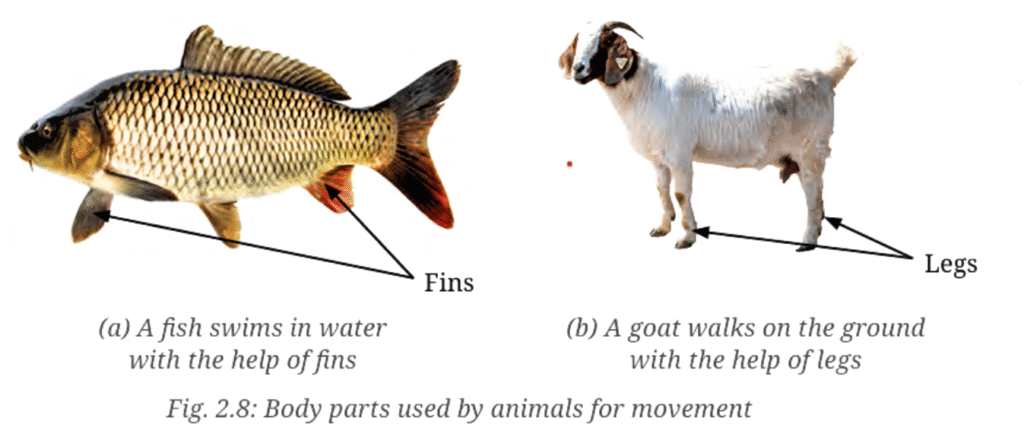
3. Habitats and Adaptations
A habitat is the natural home of a plant or animal. It provides food, water, air, and shelter.
- Terrestrial habitats (land) – Forests, deserts, mountains, grasslands.
- Aquatic habitats (water) – Rivers, lakes, ponds, seas.
- Amphibians – Animals like frogs live both on land and water.
Adaptations are special features that help organisms survive in their habitat.
- In deserts:
- Cactus stores water in its stem.
- Camels store fat in their humps and can live without water for days.
- In mountains:
- Deodar trees are cone-shaped to shed snow.
- Mountain goats have strong hooves to climb steep rocks.
- In oceans:
- Fish have streamlined bodies and gills to breathe.
- Seaweed can grow underwater.
- In forests:
- Tall trees grow close together to get sunlight.
- Lions blend with the environment to hunt.
4. Biodiversity and Conservation
The variety of living organisms is called biodiversity. Every plant and animal has a role – trees provide fruits and oxygen, animals help spread seeds, and birds control insect numbers.
But biodiversity is in danger because of cutting forests, hunting, and pollution. To protect it, India started projects like:
- Project Tiger (1973) – To protect tigers.
- Project Cheetah (2022) – To bring back cheetahs.
- Protected Areas – National Parks, Wildlife Sanctuaries.
- Sacred Groves – Forest patches protected by communities for cultural reasons.
Conservation ensures that plants and animals survive for future generations.
- CLASS 6 NCERT BOOK: FREE DOWNLOAD
- CLASS 7 NCERT BOOK: FREE DOWNLOAD
- CLASS 8 NCERT BOOK: FREE DOWNLOAD
- CLASS 9 NCERT BOOK: FREE DOWNLOAD
- CLASS 10 NCERT BOOK: FREE DOWNLOAD
Mind Map for Class 6 Science Chapter 2 – Diversity in Living
All these concepts are beautifully arranged in the mind map for Class 6 Science Chapter 2 Diversity in Living World. Instead of memorizing long notes, students can look at this single-page mind map and recall every important point.
👉 Download Mind Map for Class 6 Science Chapter 2 PDF here
The PDF is free to access and is designed to support:
- Students – for quick revision.
- Teachers – for classroom explanation.
- Parents – to help children with simple study tools.
Why Use a Mind Map for Class 6 Science Chapter 2 – Diversity in Living World?
Studying Chapter 2 of Class 6 Science, Diversity in Living World, can feel like exploring a big forest—you see plants, animals, habitats, and so many new words all at once. Sometimes, it becomes tricky to keep everything in mind. This is where a mind map really helps.
A mind map takes the whole chapter and turns it into a simple drawing. From the central topic—“Diversity in Living World”—different branches spread out showing plants, animals, adaptations, habitats, and conservation. With just one look, you can connect the dots between ideas that earlier seemed scattered across pages.
The biggest advantage is clarity. When students see how “trees, shrubs, and herbs” link to plant classification, or how “herbivores, carnivores, omnivores” connect under animals, it suddenly makes sense. It’s no longer a bunch of facts but a story that fits together.
Another benefit is memory. Our brain loves visuals more than long text. When key words, colours, and simple diagrams are used in the mind map, they stick. So when the exam comes, it’s easier to recall that cactus stores water in deserts or that deodar sheds snow on mountains.
Mind maps are also perfect for revision. Instead of reading the entire chapter again, you can look at a single page and refresh the whole lesson in a few minutes. This makes last-minute studying much less stressful.
Finally, mind maps save time and make learning active. Instead of passively reading lines, students engage with the chapter. They begin to notice patterns, ask questions, and even enjoy making their own maps.
That’s why the mind map for Class 6 Science Chapter 2 Diversity in Living World is such a handy tool. It turns a heavy chapter into something light, visual, and easy to revise.
You can also download the PDF of the mind map for Class 6 Science Chapter 2 prepared by Vidyayan Academy and keep it for regular practice.
How to Use This Mind Map
A mind map works best when used in the right way. Here are some simple steps:
- Read the textbook first to understand the basics.
- Use the mind map as a summary tool for revision.
- Practice writing answers by following the branches of the mind map.
- Keep a printed copy near your study table for regular recall.
- Use it in group study sessions – one student explains while others listen.
With this approach, learning becomes more active and less time-consuming.
Benefits of the Mind Map PDF
The mind map for Class 6 Science Chapter 2 PDF download is not just a revision aid. It provides several advantages:
- Covers the whole chapter in one glance.
- Helps in last-minute revision before exams.
- Improves memory retention through visual learning.
- Builds confidence while answering in exams.
- Saves hours of note-making.
Students often find that their revision time is cut in half when they use a mind map.
Frequently Asked Questions
Q1. What is the main idea of Mind map for class 6 Science Chapter 2?
Ans: The main idea is to understand the diversity of living organisms, their habitats, adaptations, and the importance of conservation.
Q2. Why should I download the mind map for Class 6 Science Chapter 2?
Ans: Because it provides the entire chapter in a simple diagram, making revision quick and effective.
Q3. Is the PDF free?
Ans: Yes, the mind map for Class 6 Science Chapter 2 PDF download by Vidyayan Academy is completely free.
Q4. Who can use this mind map?
Ans: Students, teachers, and even parents who want to simplify the learning process.
Final Thoughts
The mind map for Class 6 Science Chapter 2 Diversity in Living World pdf is one of the best study resources for young learners. It explains plants, animals, habitats, adaptations, and conservation in a clear, visual way. Whether you are preparing for exams or just revising at home, this mind map makes the process easy and engaging.

